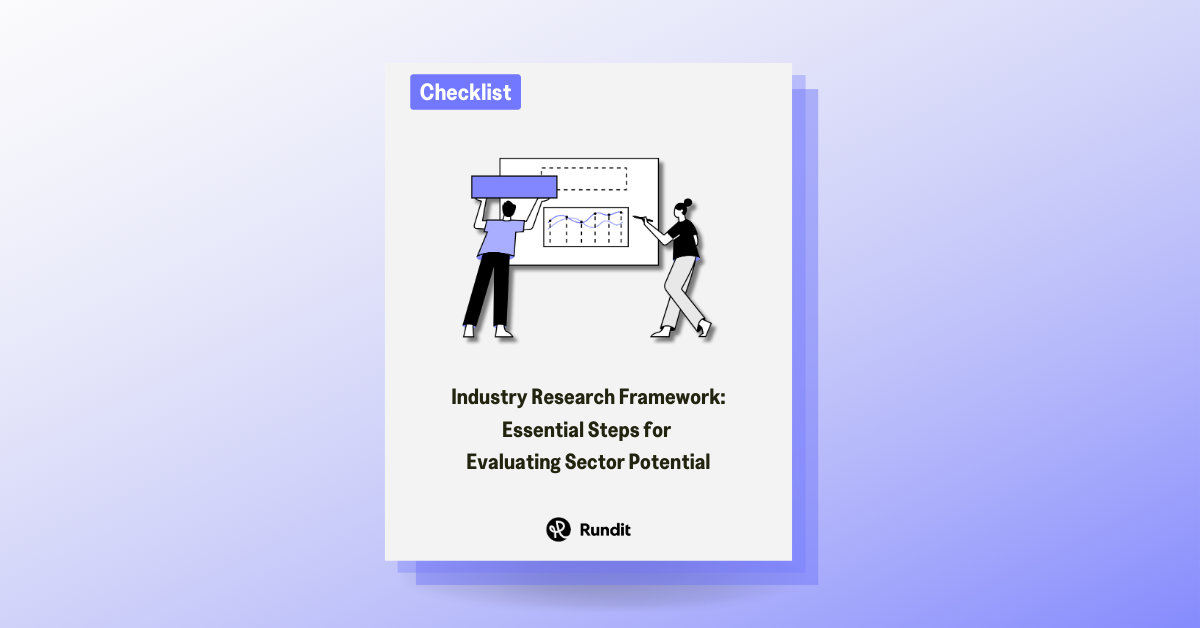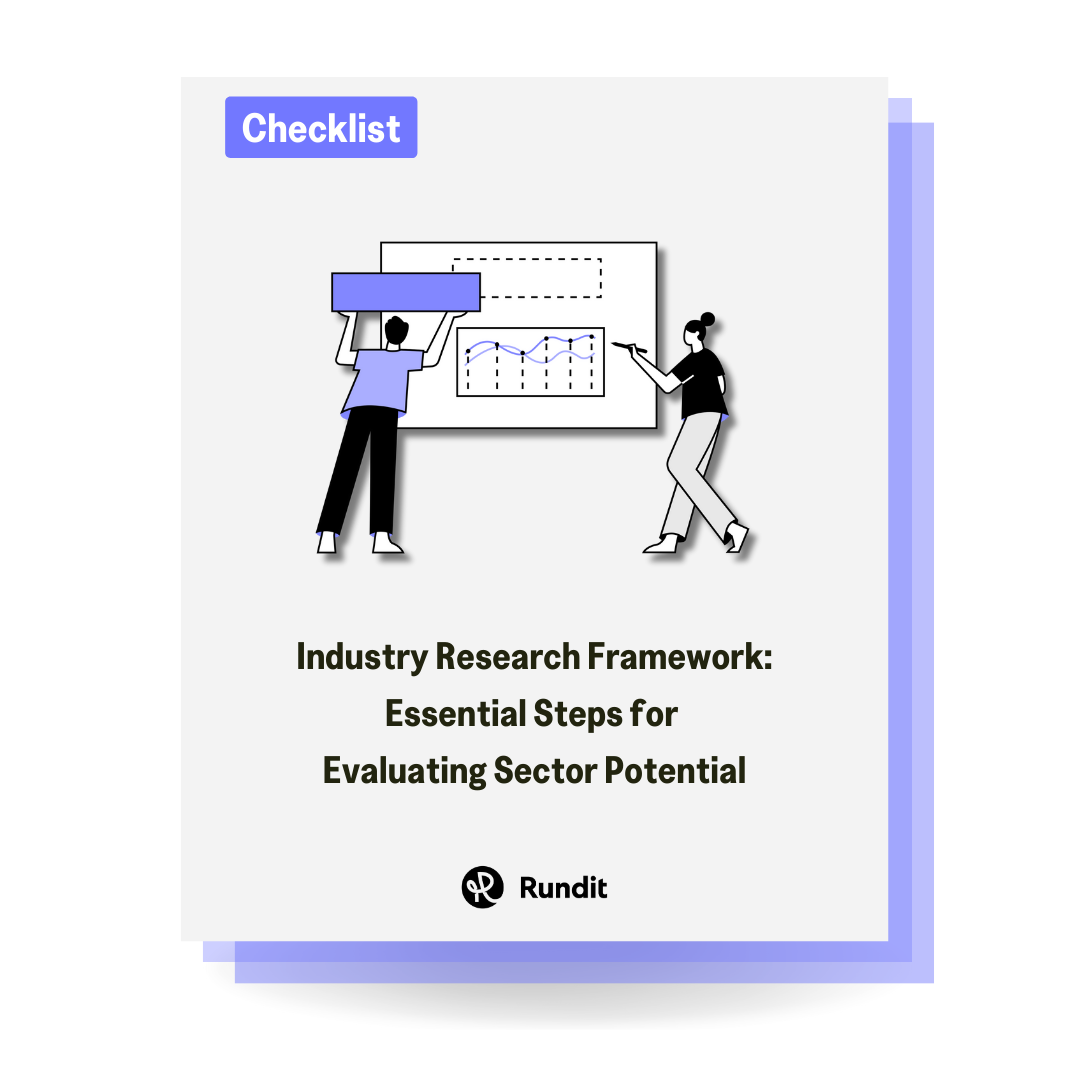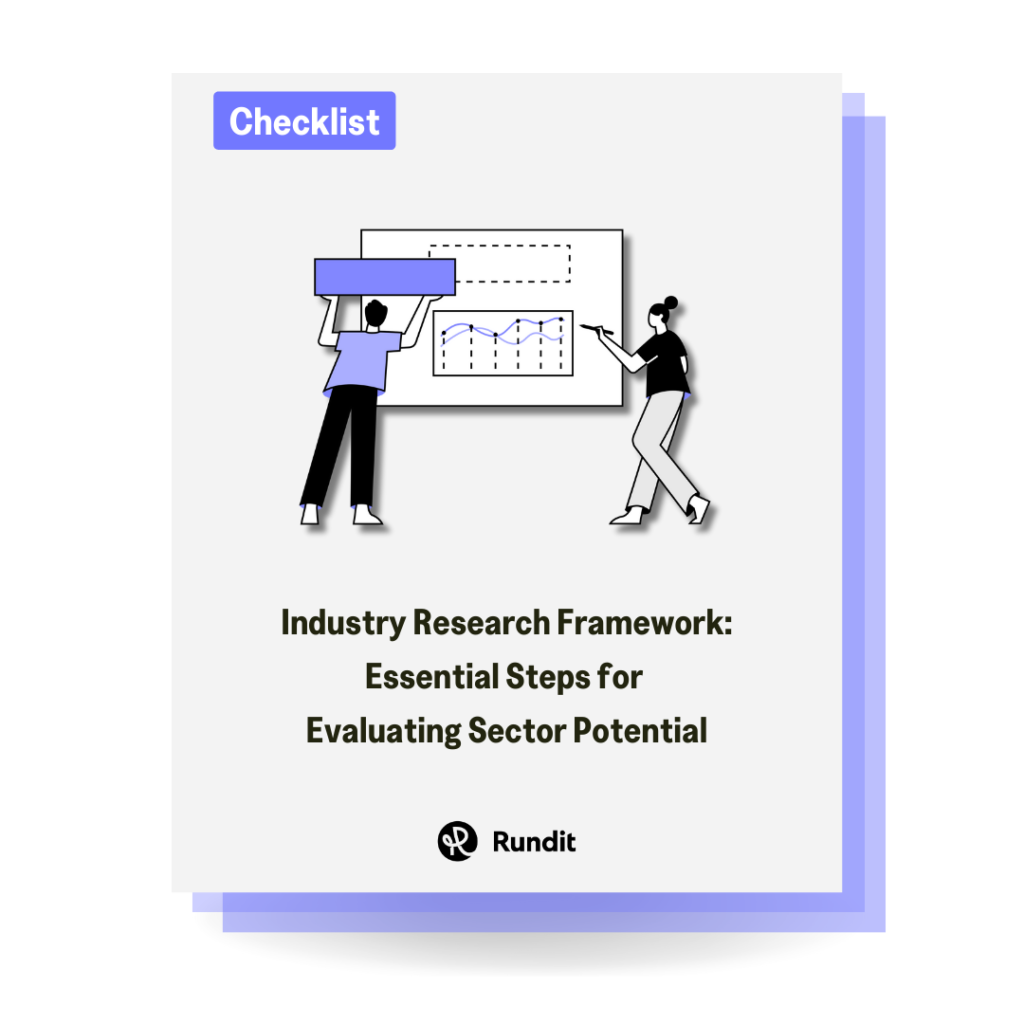
Table of Contents
Evaluating sector potential and investment opportunities involves assessing market size, growth, and trends. This includes analyzing the competitive landscape and market share, understanding industry-specific regulations, and investigating technological advancements. Additionally, it requires examining macroeconomic indicators like GDP growth and inflation and reviewing supply chain structures, including key suppliers and distribution channels.
Ready to dive in? Download our checklist “Industry Research Framework: Essential Steps for Evaluating Sector Potential”!

Set Clear Objectives: Clearly defining the purpose of the research is essential for maintaining focus and ensuring the research is targeted. Objectives might include entering a new market, making informed investment decisions, or conducting a competitive analysis. Having specific goals allows researchers to tailor their approach and gather relevant data, enhancing the effectiveness and applicability of the research outcomes.
Scope Definition: This involves specifying the particular industry or sector to be analyzed, which helps in narrowing down the research to a manageable level. Identifying the geographic focus, whether it’s local, national, or international, ensures the research is contextually relevant. Additionally, setting a time frame for the analysis, such as the current year or the next five years, provides a temporal boundary. This aids in structuring the research process and makes future predictions more accurate.
Primary Sources: Collecting data directly from sources such as surveys, interviews, focus groups, and direct observations helps obtain firsthand information that is directly relevant to the industry. This approach ensures the data is specific, current, and tailored to the research objectives, providing unique insights from industry experts, stakeholders, and consumers.
Secondary Sources: Utilizing existing industry reports, market research databases, and government publications provides a broader context for the primary data. These sources offer well-established insights and trends, helping to validate and complement the primary data, thereby ensuring a comprehensive and well-rounded analysis.
Industry Definition and Segmentation: Clearly defining the industry and its sub-sectors helps in understanding the overall market structure. This involves identifying and categorizing different market segments, which is essential for pinpointing specific areas of interest and focus. By segmenting the market, businesses can better target their strategies and tailor their offerings to meet the needs of distinct segments.
Market Size and Growth: Calculating the current market size provides a snapshot of the industry’s economic scale. Analyzing historical growth rates helps in understanding past performance trends. This analysis is crucial for forecasting future growth, aiding in investment decisions and strategic planning.
Key Players: Identifying major companies within the industry and analyzing their market shares provides valuable insights into the competitive landscape. Understanding which companies dominate the market and their relative market positions helps in assessing the competitive dynamics and potential market opportunities.
Macroeconomic Factors: Reviewing broader economic indicators such as GDP, employment rates, and inflation helps in understanding the overall economic environment in which the industry operates. These indicators provide context on the health of the economy, consumer spending power, and potential growth prospects, impacting industry performance.
Industry-Specific Indicators: Assessing specific metrics like production levels, sales volumes, and price trends offers a detailed view of the industry’s economic health. These metrics reveal the industry’s output, demand dynamics, and pricing power, providing insights into operational efficiency and market trends essential for strategic decision-making.
Current Trends: Identifying key trends that shape the industry, such as technological advancements and shifts in consumer behavior, is vital for understanding current market dynamics. Technological innovations can lead to new products, services, and processes that revolutionize the industry, while shifts in consumer preferences can influence demand and create new market opportunities. Staying abreast of these trends enables companies to adapt their strategies, stay competitive, and meet evolving consumer needs effectively.
Growth Drivers: Determining the factors driving growth within the industry helps in pinpointing areas ripe for expansion and investment. These drivers can include innovation, which fosters new product development and efficiency improvements, and demographic changes, which can create new markets or expand existing ones. By understanding these growth drivers, businesses can strategically invest in areas that promise the highest returns and long-term viability, ensuring sustained growth and profitability.
Challenges and Barriers: Recognizing potential obstacles such as regulatory hurdles, market saturation, and supply chain issues is crucial for effective risk management and strategic planning. Regulatory hurdles can increase operational costs and complexity, market saturation can limit growth prospects, and supply chain disruptions can affect production and delivery. By identifying these challenges early, businesses can develop mitigation strategies, such as diversifying supply chains, innovating to differentiate products, or lobbying for favorable regulatory conditions. This proactive approach ensures that companies are better prepared to navigate risks and maintain resilience in a competitive market environment.
Market Structure: Analyzing the market structure, whether it is a monopoly, oligopoly, or fragmented, helps in understanding the competitive dynamics. A monopoly indicates a single dominant player, an oligopoly suggests a few key players, while a fragmented market has many small competitors. This analysis is crucial for strategizing market entry and competitive positioning.
SWOT Analysis: Conducting SWOT (Strengths, Weaknesses, Opportunities, Threats) analysis for key players and the industry as a whole provides a comprehensive view of competitive positioning. This helps in identifying the internal strengths and weaknesses of companies and external opportunities and threats they face. SWOT analysis is essential for strategic planning and identifying areas for improvement and growth.
Competitive Strategies: Examining the strategies employed by leading companies, such as pricing, product differentiation, and market expansion, offers insights into effective market approaches. Understanding these strategies helps businesses to benchmark their performance, adopt best practices, and develop unique strategies to gain a competitive edge in the market.
Current Regulations: This involves identifying laws and regulations that directly impact the industry. Understanding the legal frameworks governing the sector is essential to ensure compliance and avoid legal issues. Being aware of current regulations helps businesses align their operations with legal requirements, minimizing the risk of fines, penalties, or operational disruptions.
Compliance Requirements: Evaluating the specific compliance requirements necessary for operating within the sector is crucial. This includes obtaining the necessary permits, licenses, and adhering to industry standards and guidelines. Ensuring compliance not only helps in avoiding legal troubles but also builds credibility and trust with customers and stakeholders.
Future Regulatory Changes: Keeping an eye on potential changes in regulations that could affect the industry helps in anticipating and preparing for future legal adjustments. Monitoring proposed legislation and regulatory trends allows businesses to proactively adapt their strategies, ensuring they remain compliant and can mitigate any negative impacts. This foresight helps in maintaining operational stability and strategic agility in a constantly evolving legal landscape.
In today’s dynamic landscape, staying abreast of emerging technologies is crucial for anticipating industry trends and disruptions. Identifying technologies poised to make significant impacts allows businesses to strategically invest in innovation and maintain a competitive edge. Adoption rates of these technologies provide valuable insights into market readiness and can guide decision-making on resource allocation and timing of product launches.
Furthermore, evaluating R&D and innovation activities within the industry reveals its commitment to continuous improvement and future growth. High levels of investment in R&D signify a proactive approach to staying ahead in a rapidly evolving market, fostering new solutions, and enhancing product offerings. By closely monitoring these factors, businesses can effectively navigate technological shifts, capitalize on emerging opportunities, and position themselves as leaders in their respective fields. This comprehensive approach not only fosters innovation but also ensures sustained relevance and competitiveness in an increasingly tech-driven world.
Consumer behavior analysis involves a comprehensive examination of several key aspects to understand market dynamics effectively. Starting with demographics, this entails studying variables such as age, income levels, and geographical location of consumers within a specific industry. These factors provide crucial insights into the target audience’s composition and potential buying power.
Understanding consumer preferences, needs, and pain points is equally essential. This involves delving into what motivates consumers to choose one product or service over another, their expectations, and the challenges they face. Such insights help in crafting targeted marketing strategies and product offerings that resonate with the audience.
Reviewing spending patterns and trends within the target market is another critical aspect. It involves analyzing how consumers allocate their budgets across different categories related to the industry. Identifying trends in expenditure and predicting future patterns is also crucial. This information aids businesses in making informed decisions regarding pricing, promotions, and product development. Consequently, businesses can ensure alignment with consumer behavior and market demands. Together, these analyses form a robust foundation for developing effective marketing strategies and enhancing overall consumer satisfaction and engagement.
Examining the financial performance of leading companies involves assessing their revenue generation, profit margins, and overall profitability trends. This analysis provides insights into market positioning, operational efficiency, and potential competitive advantages within the industry. Additionally, analyzing recent investment trends and funding activities offers a glimpse into investor sentiment, growth prospects, and emerging opportunities. Valuation metrics such as P/E ratios and EBITDA multiples are crucial for evaluating market perceptions of a company’s worth and growth potential. Comparing these metrics across industry peers helps identify investment opportunities and understand market dynamics influencing valuation trends. This analysis ultimately guides strategic decision-making and investment strategies within the sector.
This step focuses on recognizing potential risks such as market volatility, regulatory changes, and technological disruptions. Market volatility might include fluctuating demand or supply chain disruptions. Regulatory changes encompass new laws or amendments impacting industry operations. Technological disruptions refer to innovations that could render current practices obsolete.
Each identified risk is assessed for its potential impact and likelihood. This involves analyzing how significantly a risk could affect the sector and the probability of its occurrence. For instance, market volatility’s impact on revenue, the likelihood of regulatory changes affecting operational costs, and the chances of technological advancements altering competitive dynamics are examined.
Developing mitigation strategies involves creating actionable plans to reduce or manage the identified risks. To address market volatility, diversifying investments can be beneficial. Ensuring compliance through proactive policy monitoring helps manage regulatory changes. Technological disruptions can be effectively countered by investing in research and development. These strategies aim to minimize adverse effects and maintain sector stability.
Executive Summary: Begin by summarizing the key findings and insights derived from the research. This provides a concise overview of the most critical information.
Detailed Analysis: Present a comprehensive analysis of each section, covering the regulatory environment, market trends, competitive landscape, financial performance, and risk assessment. This detailed examination ensures a thorough understanding of each aspect.
Strategic Recommendations: Based on the detailed analysis, provide actionable recommendations. These should be specific strategies to capitalize on opportunities or mitigate risks, tailored to the industry and organization’s objectives.
Visual Aids: Use charts, graphs, and tables to illustrate key points. Visual aids enhance understanding, highlight trends, and support the narrative, making the analysis more accessible and impactful.
Continuous Monitoring: Regularly monitor industry trends to ensure the analysis remains current and relevant. This involves keeping an eye on market developments, technological advancements, and regulatory changes.
Feedback Loop: Collect feedback from stakeholders, including investors, industry experts, and internal teams. Incorporate this feedback into future analyses to improve accuracy and relevance.
Reassess Objectives: Periodically reassess the research objectives to ensure they align with the evolving business goals and market conditions. Adjust the scope of the analysis as needed to address new opportunities or challenges, maintaining the relevance and effectiveness of the research framework. This iterative process ensures the strategy remains dynamic and responsive to change.
Genei.io – “How to Conduct Industry Research: An Introductory Writing Guide“.

At Rundit, we understand the importance of streamlined portfolio management and efficient LP reporting in the venture capital world. Our platform is designed to support the seamless flow of data from the back office to the front office, enhancing your decision-making process with unparalleled transparency and efficiency.
With Rundit, you can access your portfolio data all in one place, eliminating the need for cumbersome spreadsheets. Our solution offers automated dashboards and interactive portfolio reports, enabling your team to manage investments in a modern and efficient manner.
Interested? Feel free to book a call with us here – Talk to Sales